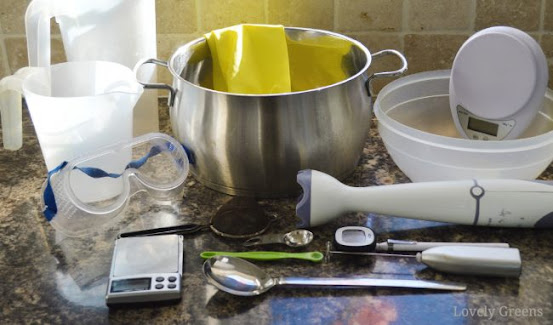Home-made soap for a better world! 自製肥皂,讓世界更美好!
If you can make your own soap, why bother spending more money on this product!.
如果您可以自己製造肥皂,何必花更多的錢在本產品上!
這是一種既經濟又解決方案的解決方案,可以創造出安全,優質且符合您的喜好的產品。此外,通過自己製造肥皂,您還可以通過減少化學製品的使用和製造行業產生的其他廢物來減少對環境的污染。
So how to make handmade soap? Let's follow up right now! 那麼如何製作手工皂呢?讓我們馬上來了解吧!
Preparation 準備材料:
Equipment 工具
silicone soap molds 矽膠皂模具
silicone baking pans 矽膠烤盤
stainless steel thermometer 不銹鋼溫度計
stick blender 棒式攪拌機
Ingredients 材料
⅔ cup unrefined coconut oil (to produce good lather)
⅔ cup olive oil (which makes a hard and mild bar)
- ⅔ cup almond oil (grapeseed, sunflower, or safflower oil will also work, just make sure it's a liquid oil)¼ cup lye (100% sodium hydroxide … you can also find at local hardware stores)● ⅔杯未精製的椰子油(產生良好的泡沫)● ⅔杯橄欖油(硬而溫和的棒狀)● ⅔杯杏仁油(菜籽油,向日葵油或紅花油也可以,只需確保它是液體油即可)● ¼杯鹼液(100%氫氧化鈉……您也可以在當地的五金店找到)Instructions: 方法Step 1:Use newspaper to cover the surface. Put on your gloves and any other safety equipment you have. In a quart canning pot, measure out your water. Prepare yourself with a spoon. Make sure you have ¼ cup of lye when you measure it. Pour the lye into the water in a slow, steady stream, stirring constantly. To stop the fumes, stand back while stirring. Enable the water to settle as it begins to clear before proceeding to the next stage.步驟1:用報紙蓋住表面。戴上手套和其他任何安全設備。在一個夸脫的罐頭罐中,量出水。用勺子準備自己。測量時,請確保您有¼杯鹼液。將鹼液緩慢,穩定地倒入水中,不斷攪拌。要阻止煙霧,請在攪拌的同時退後一步。在開始下水之前,先使水沉澱下來,然後再進行下一階段。Step 2:Combine the three oils in the pint container. They should just make a pint. Heat the oils in a microwave for about a minute, or heat them in a pan of water. Check the temperature of your oils; they should be about 120 degrees Fahrenheit. By then, your lye should have cooled to about 120°. Allow both to cool to a temperature of 95° to 105°. This is crucial when producing soap. It will come together easily if the temperature is too cold, but it will be coarse and crumbly.第2步:將三種油混合在品脫容器中。他們應該喝一品脫。在微波爐中加熱油約一分鐘,或在鍋中加熱。檢查您的機油溫度;它們應該在華氏120度左右。屆時,您的鹼液應已冷卻至約120°。讓兩者都冷卻到95°至105°的溫度。這在生產肥皂時至關重要。如果溫度太冷,它們很容易結合在一起,但會變得粗糙而易碎。Step 3Pour the oils into a mixing bowl until the lye and oils have reached the desired temperature. Slowly drizzle in the lye, stirring constantly until thoroughly combined. Hand-stir for a total of 5 minutes. It's important to have as much lye as possible in contact with as much soap as possible. You can either keep stirring or use an immersion blender after about 5 minutes. The color of the soap mixture will lighten and it will thicken. As it resembles vanilla pudding, you've reached "trace" and can proceed.第三步:將油倒入攪拌碗中,直到鹼液和油達到所需溫度為止。在鹼液中慢慢下毛毛雨,不斷攪拌直至完全混合。手動攪拌5分鐘。重要的是要使鹼液與盡可能多的肥皂接觸。大約5分鐘後,您可以繼續攪拌或使用浸入式攪拌器。肥皂混合物的顏色會變淺,並且會變稠。由於它類似於香草布丁,因此您已經達到“痕跡”並且可以繼續進行。Step 4At this stage, you can add your herbs, essential oils, or other ingredients. To mix, thoroughly stir all together. Cover with plastic wrap after pouring the mixture into the mold. Cover it in an old towel to keep it warm. The residual heat will be retained, and the saponification process will begin. Saponification is the transformation of the raw materials into soap.第四步:在此階段,您可以添加草藥,精油或其他成分。混合時,請充分攪拌均勻。將混合物倒入模具後,用保鮮膜蓋好。用舊毛巾蓋住它以保持溫暖。殘留的熱量將被保留,並且皂化過程將開始。皂化是將原材料轉化為肥皂。Step 5:Test your soap after 24 hours. Let it sit another 12-24 hours if it's still warm or soft. Turn it out onto parchment paper or a baking rack until it has cooled and firmed up. Cut into a bar using a loaf pan as a mold. Leave the bars for a 4-week cure period and be sure to flip the bar once a week to allow air to circulate on all sides.第五步:
24小時後測試您的肥皂。如果天氣仍然溫暖或柔軟,請再靜置12-24個小時。將其翻到羊皮紙或烤架上,直到冷卻並固定。切成條狀,用麵包盤作為模具。將皂條保留4週的固化期,並確保每週翻轉該皂條一次,以使空氣在所有側面流通。
Step 6
Cover your soap in wax paper or store it in an airtight jar until it has completely cured. Handcrafted soap produces its own glycerin, a humectant that draws moisture from the air. It should be wrapped to prevent the moisture from attracting dust and debris.
第六步
用蠟紙蓋住肥皂,或將其存放在密閉的罐子中,直到完全固化。手工肥皂會產生自己的甘油,甘油是一種從空氣中吸收水分的保濕劑。應將其包裹起來,以防止水分吸引灰塵和碎屑。







